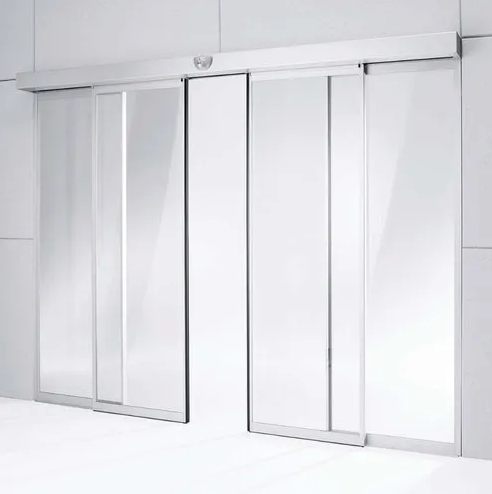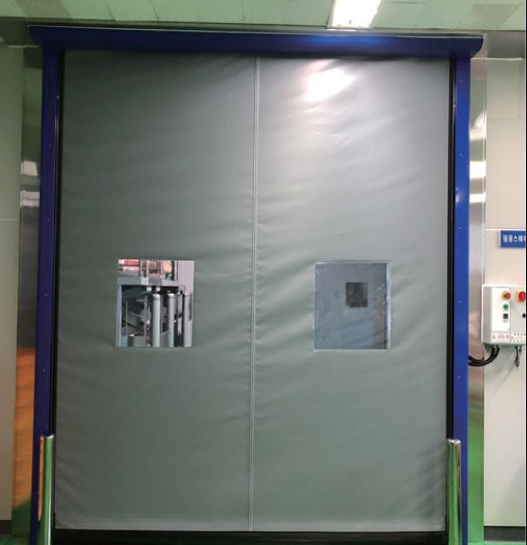Various sensors like infrared, microwave, ultrasonic, laser, and capacitive sensors are commonly used in automatic doors, each with specific advantages and limitations.
Types of Automatic Doors
Automatic doors have become increasingly common due to the convenience they offer in various settings, from commercial establishments to public transport facilities. They ensure easy access, energy conservation, and enhanced security. Let’s delve deeper into the different types of automatic doors available in the market.

Sliding Doors
Sliding doors are typically seen in large commercial spaces, airports, and shopping malls. They operate by sliding horizontally, usually parallel to a wall. There are two main types:
Single-slide: One door leaf slides to the side.
Bi-parting: Two door leaves slide apart from the middle.
Advantages:
Efficient use of space.
Suitable for wide entrances.
Wikipedia Link on Sliding Doors
Swing Doors
Swing doors are similar to traditional doors but with automated mechanisms. They swing either inwards or outwards, and are popular in offices and some retail stores.
Types:
Single swing: One door leaf that swings in one direction.
Double swing: Two door leaves that can swing in both directions.
Advantages:
Gives a traditional aesthetic appeal.
Can be easily integrated into existing door frames.
Revolving Doors
Revolving doors consist of three or four panels attached to a central shaft that rotates inside a cylindrical enclosure. They are commonly found in large hotels and commercial buildings due to their ability to handle high foot traffic while minimizing heat loss.
Benefits:
Energy efficient as they prevent drafts.
Manage large crowds effectively.
Wikipedia Link on Revolving Doors
Foldable Doors
Foldable doors, or accordion doors, fold into themselves when opened. They are useful in spaces where there is a need to completely open up a room or divide it.
Key Features:
Versatile and space-saving.
Suitable for both residential and commercial applications.
Advantages:
Provides flexibility in space utilization.
Can be customized for different looks and finishes.
Wikipedia Link on Folding Doors
Types of Sensors
Sensors play a critical role in the functioning of automatic doors, detecting the presence of people and objects and triggering the doors to open or close accordingly. There are several types of sensors used in automatic doors, each with its own set of advantages and applications. Let’s delve into the details of each type.
Infrared Sensors
Infrared sensors rely on emitting and detecting infrared light to identify the presence of an object or person. These sensors are commonly used in automatic sliding and swinging doors.
Types:
Active Infrared: Emit infrared light beams and detect reflections.
Passive Infrared: Detect changes in the infrared energy in the environment.
Advantages:
Cost-effective.
Low power consumption.
Wikipedia Link on Infrared Sensors
Microwave Sensors
Microwave sensors emit microwaves and measure the reflection off a moving object. They are primarily used in industrial settings due to their long-range capabilities.
Types:
Continuous Wave Radar: Emit microwaves continuously to detect motion.
Pulse Doppler Radar: Emit pulses and measure their Doppler shift to detect velocity.
Advantages:
Can detect motion through non-metallic objects.
High sensitivity and range.
Wikipedia Link on Microwave Sensors
Ultrasonic Sensors
Ultrasonic sensors generate high-frequency sound waves and measure the time it takes for the echo to return after hitting an object. These are widely used in automatic doors for retail stores and hospitals.
Features:
Sound frequency above 20 kHz.
Sensing range between 2 cm and 7 m.
Advantages:
Accurate distance measurement.
Not affected by color or transparency of objects.
Wikipedia Link on Ultrasonic Sensors
Laser Sensors
Laser sensors use laser light to measure distances and are often found in high-precision environments like laboratories or manufacturing plants.
Types:
Time-of-Flight: Measures the time taken for a laser beam to hit an object and return.
Triangulation: Uses the angle of the incoming laser light to measure distance.
Advantages:
High precision and accuracy.
Suitable for long-range applications.
Wikipedia Link on Laser Sensors
Capacitive Sensors
Capacitive sensors detect changes in electrical capacitance in their proximity, often used for touch-activated automatic doors.
Key Features:
Sensing range is usually less than 10 cm.
Commonly used in controlled environments like labs.
Advantages:
Highly sensitive to touch.
Capable of detecting through non-conductive materials like glass.
Wikipedia Link on Capacitive Sensing

How Sensors Work in Automatic Doors
Understanding how sensors work in automatic doors is essential for both users and installers. These mechanisms ensure smooth, safe, and efficient operation. Let’s examine the key aspects of how these sensors function in automatic doors.
Detection Mechanism
The core function of a sensor in an automatic door system is to detect the presence of a person or object. This detection usually happens in one of several ways, depending on the type of sensor:
Infrared: Detects heat emitted from the body. Microwave: Emits microwaves and measures their reflection. Ultrasonic: Sends out sound waves and calculates the time taken for the echo to return. Laser: Measures the time taken for a laser beam to hit an object and bounce back.
Advantages and Disadvantages:
Infrared is less expensive but can be affected by environmental factors.
Microwave can detect through walls but is more costly.
Wikipedia Link on Detection Theory
Activation and Deactivation
Once a sensor detects an object or person, the next step is to activate the door mechanism. This process also varies based on the sensor’s type and settings:
Immediate Activation: The door opens as soon as the sensor detects a presence. Delayed Activation: There’s a brief pause before the door opens, usually for safety or energy-saving reasons.
Deactivation:
Exit Sensor: Some doors have a separate sensor on the inside for exit-only activation.
Wikipedia Link on Control Systems
Sensor Positioning and Calibration
The placement and calibration of sensors are crucial for the optimal functioning of automatic doors.
Positioning:
Overhead: For sliding and swing doors, sensors are often placed overhead.
Sidelong: For revolving doors, sensors may be placed on the sides.
Calibration:
Sensitivity: Adjusted according to the expected traffic and type of usage.
Range: Set based on how close a person should be to activate the door.
Comparison of Different Sensors
Selecting the right sensor for an automatic door system is a critical decision, requiring a balance among various factors like accuracy, cost, reliability, and range. Let’s dig deeper into these considerations to help you make a more informed decision.
Accuracy
Accuracy is a top priority when it comes to automatic door sensors. Here’s how different types fare:
Infrared: Offers reasonable accuracy, but may give false positives due to heat sources. Microwave: Extremely accurate, particularly suitable for high-security environments. Ultrasonic: Highly accurate for close-range applications. Laser: Offers pinpoint accuracy, usually used in specialized environments. Capacitive: Excellent for touch-based applications but limited to short ranges.
Wikipedia Link on Measurement Accuracy
Cost
Budget considerations can significantly influence sensor selection.
Infrared: Generally the most cost-effective option. Microwave: More expensive due to the technology and range. Ultrasonic: Moderately priced, suitable for various applications. Laser: Generally the most expensive due to high accuracy and range. Capacitive: Prices vary but are generally moderate.
Wikipedia Link on Cost–benefit Analysis

Reliability
Long-term reliability is crucial to prevent frequent repairs and replacements.
Infrared: Fairly reliable but can be affected by environmental conditions. Microwave: Highly reliable and can work through walls and other non-metallic obstructions. Ultrasonic: Reliable for indoor use but affected by wind and temperature outdoors. Laser: Extremely reliable but susceptible to interference from other light sources. Capacitive: Highly reliable in controlled environments.
Wikipedia Link on Reliability Engineering
Sensitivity and Range
The sensor’s sensitivity and range influence how well it will suit your specific application.
Infrared: Moderate sensitivity and limited to close ranges. Microwave: High sensitivity and long-range capabilities. Ultrasonic: Adjustable sensitivity and moderate range. Laser: Extremely sensitive and capable of long-range detection. Capacitive: Very sensitive but limited to very short ranges.
Wikipedia Link on Sensory Analysis
